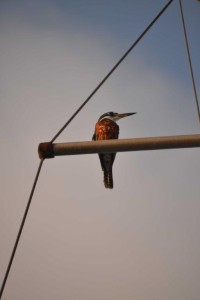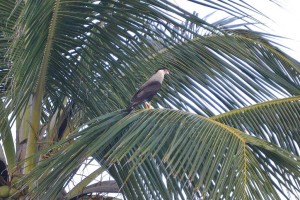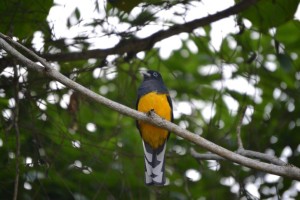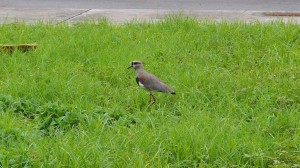I’m sure that at least some of you are wondering if there are really as many birds here as in the animated film Rio. The answer is no, but almost. Here in the city they are small and easy to miss if you are not looking. Hummingbirds especially, can pass unnoticed. They flit about so fast and they are so small that it is hard to follow them. They also sit down often and are so well camouflaged that you easily lose them. At the top of the Corcovado I was trying to take a picture of a male Violet-capped Woodnymph (Thalurania glaucopis) (but at that time I hadn’t known what type of hummingbird it was), and once I actually had it perfectly focused on the bird, but I thought it was a twig or leaf sitting there, and in the split-second it took me to realise my mistake the little bird had flown off.
It really has suprised me exactly how many birds are here in the city, Usually you only get Feral Pigeons (Columba livia) and House sparrows (Passer domesticus) in cities, but here, there is even a falcon living close to the yacht club! I know because I hear it almost every day. It makes a high-piched “skree” kind of sound. Also, as the falcon is at the top of its food chain, its presencs indicates that its eco-system is healthy.
The one bird that is a definite exception to the “big birds are scarce and hard to see” rule, is the Black Vulture (Coragyps atratus). It can constantly be seen soaring in the sky over the many hills in and next to the city, wings outstretched, the tip feathers reaching as far as they can. They are ugly black birds. When they sit their feathers look heavy and their naked heads look as if it could belong to dinosaurs, but when they soar up high overhead, they look majestic.
As for Ilha Grande, you could feel the island pulsating with birds and hear their chirps coming from the jungle. Most of the time we were there is was rainy and misty. The island was soflty enveloped by bits of floating cotton wool puffs seeping into the jungle. It made the island seem sleepy – as if patiently waiting for the sun to come back while enjoying the soft droplets of moisture the cotton puffs brought. I sat on the boughsprit and just enjoyed the quiet. I like people and outings and excitement, but it is in quiet moments like these in nature, where it is just me with God, that I feel refreshed.
Leaving Rio is going to be exciting – because we’re finally going somewhere – but it’s also going to be sad. We haven’t just been tourists here in Rio de Janerio, we’ve lived here. We now know the best shops close to the Iate Clube. We know what treats we like most (açaí and brigadeiros are on the top of my list : ) . . .We’ve even been picking up the language! Especially my Dad, because he has to communicate with Adeolyo, our wonderful, but nonEnglish-speaking mechanic. The mechanic would say something to my Dad in a long string of words (of which I could maybe understand 1), and then my Dad gets it. Same with asking directions. In the beginning we used google translate all the time, but now my Dad can generally listen to a group of words which mean little or nothing to me, and somehow understand where we need to go. I’m sure that we would all have picked up the language if we had stayed longer, maybe with a few lessons to help sort out the tangle that verbs and tenses tend to create ; )
Here are a few of my nicer bird pictures, just because I want to : )

Ringed Kingfisher (Magaceryle torquata); it’s sitting on one of our boat’s spreaders ; picture in Rio

And this is a Southern Crested Caracara (Caracara plancus) which we saw at Ilha Grande. Don’t let the palm leaves fool you, that bird is quite big!



2 comments
Wow! You are so fortunate to see these beautiful birds. I hope when you come to Australia you will see lots here too! We have sulphur crested cockatoos, black cockatoos, galahs, kookaburra, lorikeets and lots of others that we can see from our garden – even hear an owl sometimes but haven’t managed to find it! Love to see more of your birds as you travel!!
Hi Franci,
I am just catching up on some of the blog entries all of you have done. I love ‘seeing’ these places through all of your eyes. Thanks for this interesting blog entry about the birds you have encountered. You still have many places that are filled with lovely birds. Just wait until you get to Trinidad and see the Scarlet Ibises which is their national bird. You can go on a boat ride through the mangrove swamp (I forget the name of it right now but it is famous) and see the many flocks of hundreds of these birds coming back to their roosts after a day out. Quite an amazing sight!
Unfortunately once you get to the Pacific you will find a complete lack of birdlife on the islands. The song birds have been decimated by rats. Some of the islands are trying to re-introduce the birds but it is a long and slow process. 🙁
Now I must get back to the blog and continue to catch up on your travels.
Hugs from Cath